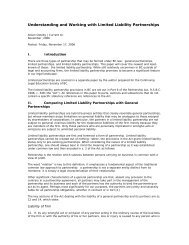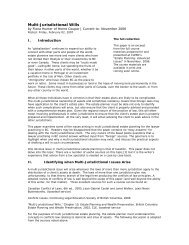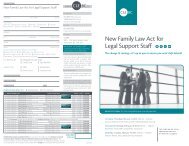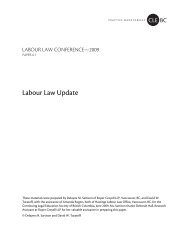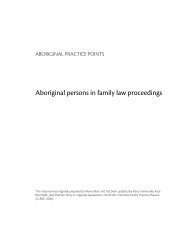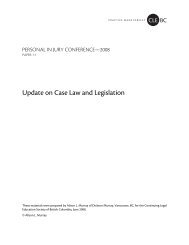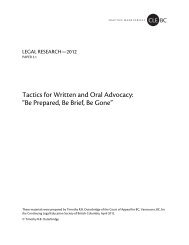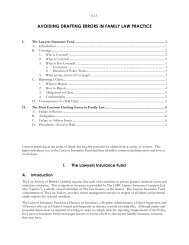Joint Ventures-The Limited Fiduciary Relationship Structure
Joint Ventures-The Limited Fiduciary Relationship Structure
Joint Ventures-The Limited Fiduciary Relationship Structure
Create successful ePaper yourself
Turn your PDF publications into a flip-book with our unique Google optimized e-Paper software.
5.1.18<br />
If the trust that is created by transferring assets to a corporation “in trust” permits discretion on the part<br />
of the trustee to deal with the property with independent powers and responsibilities, the trust will be<br />
considered a separate person for GST and tax purposes. If the trust is a “bare trust” in which the trustee<br />
does no more than hold the property and transfer on the direction of the beneficial owner, then for tax<br />
purposes one looks through the bare trust to treat the property as being dealt with by the beneficial<br />
owner. For tax purposes, a bare trustee is effectively the same as an agent for a nominee, although there<br />
are legal differences between these terms as far as Canadian tax authorities are concerned. 20 A bare<br />
trustee is a conduit for income tax purposes and is not taxed personally on profits dealing with the trust<br />
property on behalf of the beneficiary even though the bare trustee holds title to the property.<br />
Some relevant case law is as follows:<br />
In Brookview Investments v. Canada (Minister of National Revenue – M.N.R.), 21 the Court<br />
held that a corporation held property as bare trustee for a group of shareholders.<br />
<strong>The</strong>refore, the shareholders should be taxed as if they had dealt directly with the<br />
property.<br />
In Trident Holdings Ltd. v. Danand Investments Ltd., 22 the Court ruled that an agency<br />
relationship can exist contemporaneously with a bare trust. As such, a beneficiary is<br />
made the principal of the trustee who is acting as agent.<br />
In Fraser v. Canada, 23 the Court ruled that a high degree of autonomy and independence<br />
of action enjoyed by the trustee was incompatible with the notion of a “bare trust.”<br />
In Stewart v. Canada, 24 a taxpayer took title to properties, rather than having them in his<br />
corporation’s name, in order to circumvent provincial rental housing legislation. <strong>The</strong><br />
Court found no evidence of an intention to create a bare trust. Thus, the benefits from<br />
the properties were correctly included in the taxpayer’s income.<br />
<strong>The</strong> JVC model requires a shareholders’ agreement to augment the company’s articles and by-laws.<br />
Under certain corporate law statutes such as the Canada Business Corporations Act 25 (but not the BC<br />
Business Corporations Act) a unanimous shareholders’ agreement effectively becomes part of the<br />
company’s constating documents. <strong>The</strong> shareholders’ agreement will need to deal with most of the<br />
matters that a conventional contractual JV will need to deal with in respect of the contribution of assets,<br />
the management and funding of the JV and the consequences of failing to advance additional funds when<br />
required to do so. Because the participating interests in the JV are reflected in shareholdings in the JVC,<br />
there are many complexities with regards to the issuance and redemption of shares. <strong>The</strong> JVC will need<br />
to be a party to the agreement and the parties will need to decide whether additional funds are<br />
contributed by way of loan or share capital and if the latter, whether by way of common equity or<br />
preferred equity. All the complexities inherent in corporate capitalization will be applicable to this<br />
model. In addition, the parties should be sensitive to the “thin capitalization” rules under certain<br />
legislation whereby consequences flow from the JVC having inadequate equity capital (vis-a-vis the<br />
business risks it assumes) in circumstances where the parties would otherwise prefer to advance all of<br />
their funding by way of loans (for example, public transportation companies and financial intermediaries<br />
may require large equity capitalization in the public interest).<br />
20 See CRA Bulletin B-068.<br />
21 [1964] Ex. C.R. 123 (Exch. Ct.).<br />
22 (1988), 49 D.L.R. (4th) 1 (Ont. C.A.).<br />
23 [1995] F.C.J. No. 1489 (F.C.A.).<br />
24 [1996] T.C.J. No. 1014 (T.C.C.).<br />
25 R.S. 1985, c. C-44.




